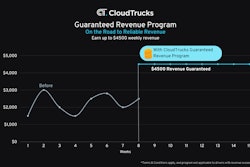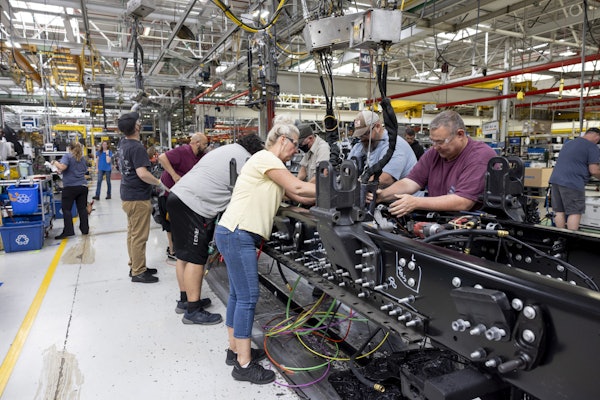The trucking industry, an essential backbone of the U.S. economy, faces an ongoing critical challenge: a significant shortage of drivers.
This shortage — 60,000 as estimated by the American Trucking Associations — is not just a transient issue. It has profound implications on the supply chain, affecting everything from the availability of everyday consumer goods to the stability of national economic growth.
The industry, alongside government entities, is implementing or exploring a variety of strategies to fill the gap, from recruiting a more diverse range of employees and offering specialized training to technological advancements such as autonomous trucks and government policy changes like more flexible hours of service.
Why the shortage?
The trucking industry’s labor challenge is multifaceted, stemming from a combination of demographic, economic and regulatory factors.
Aging workforce
One of the primary reasons for the driver shortage is the aging demographic of current drivers. Many are nearing retirement age, and there aren’t enough younger drivers entering the profession to replace them. At 46, according to the American Trucking Associations, or as high as 60 in CCJ’s 2023 “What Drivers Want” survey, the average age of a commercial truck driver in the U.S. is significantly higher than that of the overall workforce, 42, indicating a generational gap in the industry.
Challenges in attracting younger drivers
A variety of factors have made it a challenge for the industry to attract younger drivers. The demanding nature of the job, long hours away from home, and the perception of truck driving as a less desirable career path contribute to the issue. Moreover, federal regulations require commercial truck drivers to be at least 21 years old to drive interstate, which limits the pool of younger drivers who can enter the field immediately after high school.
Impact of COVID-19
The COVID-19 pandemic had a significant impact on the trucking industry. Many drivers were laid off or chose to leave due to health concerns or to care for family members. The pandemic also disrupted training and licensing processes, creating a backlog of new drivers trying to enter the industry.
Regulatory changes and implications
Over the years, regulatory changes have also affected the trucking industry. Hours-of-service regulations, designed to ensure drivers get adequate rest, also limit the number of hours a driver can work, impacting earnings and job appeal. Compliance with these and other regulations like the electronic logging device mandate add to the operational complexities for drivers and companies.
Economic factors
Economic factors play a significant role in the labor shortage. While truck driving can be lucrative, the pay structure (often based on miles driven or hours worked) and the lack of regular home time can be deterrents. The rising cost of living and stagnant wages in certain segments of the industry also contribute to the difficulty in attracting and retaining drivers.
Impact of the shortage
The truck driver shortage has wide-reaching implications that affect not just the industry, but the entire supply chain and U.S. economy.
Supply chain disruptions
The shortage directly affects the efficiency of the supply chain. With fewer drivers available, there’s a delay in the transportation of goods. This leads to longer delivery times and can cause shortages of products in various sectors, from retail to manufacturing. The just-in-time delivery model, which many businesses rely on, is particularly vulnerable to such disruptions.
Increased costs for consumers
The inefficiencies in the supply chain inevitably lead to increased costs, which are often passed on to consumers. The shortage of drivers can lead to higher shipping rates, and these increased costs can result in higher prices for goods. This inflationary effect can have a significant impact on consumer spending and the overall economy.
Challenges for trucking companies
Trucking companies are under immense pressure due to the driver shortage. They face increased operational costs, including higher wages to attract drivers, costs associated with driver turnover, and investments in recruitment and training. The competition for qualified drivers can also be intense, leading to a bidding war between companies.
Economic impact
Disruptions in trucking reverberate throughout the U.S. economic system. The driver shortage can hamper economic growth, affecting industries that rely on trucking for transportation of raw materials and finished products. It also impacts the labor market, with ripple effects in related sectors like logistics, warehousing and distribution.
Responses and solutions
Recruitment strategies
Trucking companies are intensifying efforts to attract a diverse range of candidates, including younger individuals, retirees from other fields, military veterans and foreign nationals. These campaigns often highlight the benefits of truck driving, such as competitive pay, the opportunity for travel and, for immigrants, the chance at permanent residency and stable work in America.
Training and licensing
Specialized training programs are being offered to efficiently prepare new drivers. There is also advocacy for lowering the interstate commercial driving age to 18 to expand the potential driver pool.
Technological innovations
Technological advancements, including the development of autonomous trucks, are seen as a long-term solution to the labor shortage. Meanwhile, improvements in truck technology are making the profession more attractive and less physically demanding.
Policy changes
Revising regulations, such as hours-of-service, and providing funding for training initiatives are ways the government is contributing. Furthermore, improving the efficiency of utilizing immigration programs, which allow skilled and unskilled workers, including truck drivers, to immigrate to the U.S., would benefit the industry.
A complex web of challenges makes potential solutions to the commercial truck driver shortage equally complex. Trucking companies and government agencies must be just as diverse in strategies to put more drivers on the road, ensuring stability in the supply chain and economy.













